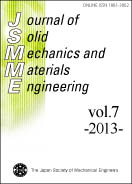All issues

Current issue
Displaying 1-5 of 5 articles from this issue
- |<
- <
- 1
- >
- >|
Papers
-
Mutsumi MIYAGAWA, Jyo SHIMURA, Takuo SUZUKI, Takanobu TAMIYA2013Volume 7Issue 6 Pages 540-552
Published: 2013
Released on J-STAGE: November 29, 2013
JOURNAL FREE ACCESSIn this paper, we derive the general solutions for many cylindrical holes or rigid inclusions perfectly bonded to an elastic medium (matrix) of infinite extent, under In-Plane deformation. These many holes or rigid inclusions have different radii and different central points. The matrix is subjected to arbitrary loading like uniform stresses at infinity. The solution is obtained, via iterations of Möbius transformation as a series with an explicit general term involving the complex potential functions of the corresponding homogeneous problem. This procedure has been termed” heterogenization”. Using these solutions, several numerical examples are shown by graphical representation.View full abstractDownload PDF (1373K) -
Mutsumi MIYAGAWA, Takuo SUZUKI, Takanobu TAMIYA, Jyo SHIMURA2013Volume 7Issue 6 Pages 553-570
Published: 2013
Released on J-STAGE: November 29, 2013
JOURNAL FREE ACCESSThis paper presents general solutions for problems involving many circular elastic inclusions that are perfectly bonded to an elastic medium(matrix) of infinite extent under in-plane deformation. These many elastic inclusions may have different radii, central points and possess different elastic properties. The matrix is assumed to be subjected to arbitrary loading, for example, by uniform stresses at infinity. The solutions were obtained through iterations of theMöbius transformation as series with an explicit general term involving the complex potential functions of the corresponding homogeneous problem. This procedure is referred to as heterogenization. Using these solutions, several numerical examples are presented graphically.View full abstractDownload PDF (1520K) -
Yoji SHIBUTANI, Tomoyuki HIROUCHI, Tomohito TSURU2013Volume 7Issue 6 Pages 571-584
Published: 2013
Released on J-STAGE: November 29, 2013
JOURNAL FREE ACCESSMicroscopic yielding can be realized by the transfer of a dislocation across a grain boundary (GB), or by incorporation between the residual GB dislocation and the dislocations nucleated in the near-field of a GB due to the applied stress. These phenomena are determined by the crystallographic orientation and the multiaxial stress state around a GB. In the present paper, a new boundary interaction criterion of L- or L'-value is proposed, which considers both the contributions of the geometric relationship between two grains and a GB, and the stress state applied to the near-field of a GB. This value and the others so far proposed were calculated for <110>, <100>, and <111> symmetric tilt grain boundaries under uniaxial compression normal to the GB. The dynamic transfer and incorporation of the dislocations nucleated under uniaxial compression normal to the GB plane were then examined using 3-dimensional molecular dynamics simulations. Two kinds of <110> symmetric tilt boundaries of copper Σ3A and Σ3B were atomistically modeled. The individual reaction process between the dislocations nucleated from an artificial Frank-Read source introduced in one grain and a GB under uniaxial compression was resolved in detail. Combinations of the preferential slip systems across GBs were discussed in reference to the proposed boundary interaction criterion. The case of Σ3B with an easier slip transfer across a GB is identical to that predicted, while incorporation of the displacement shift complete (DSC) dislocation migrated on a Σ3A boundary plane complicates the defect reaction, necessitating a larger critical stress for slip transfer across a GB.View full abstractDownload PDF (6670K) -
Seongwon YOO, Yutaka TOI2013Volume 7Issue 6 Pages 585-600
Published: 2013
Released on J-STAGE: December 19, 2013
JOURNAL FREE ACCESSThe present study newly attempts the numerical simulation of the mechanical sensors using conducting polymers which generate electricity in the transient response to mechanical stimulation. The generated electric potential in the mechanical sensors is very much smaller than the supplied electric potential of the actuators with respect to the same deformation and structure. The present simulation procedure modifies and integrates the existing theories, and then the features of the transient behaviors, e.g. the non-invertible relation between electrical potential and deformation, relaxation and hysteresis, are numerically simulated. The governing equations of the physical phenomena in the sensation are coupled by embedding driving forces with physical parameters such as solid stress, fluid pressure, ion concentration and electric potential. The governing equations and fields of the physical parameters are spatially simplified as one-dimensional in the thickness direction of the sensors, because their variations over thickness dominantly determine the behavior of the sensor. In addition, the numerical procedure is efficiently simplified as possible as the transient behaviors are expressed. Next, the undrained Poisson's ratio is modified with a correction factor, and its significant effect on the transient behavior is investigated. Lastly, the procedure of the computational system for the sensors is introduced and fully coupled simulation is conducted. As a result, the present study reports the simulation results of the important physical quantities over the microscale thickness.View full abstractDownload PDF (1430K) -
Yoshiaki NAGASHIMA, Masao ENDOU, Masahiro MIKI, Yoshio NONAKA, Ken'ich ...2013Volume 7Issue 6 Pages 601-611
Published: 2013
Released on J-STAGE: December 19, 2013
JOURNAL FREE ACCESSIn this paper, a combined model was proposed for reflection from a discontinuity and for a wave field of a fundamental shear horizontal guided wave in a plate structure. The reflection coefficient of a guided wave from a rectangular discontinuity can be modeled in the same way as the total reflection coefficient of a bulk wave. For the discontinuity having a slightly changed cross-sectional area, the reflection coefficient from the whole discontinuity can be calculated by spatial integration of the waves reflected from the divided regions. Some experiments and analyses were performed for 4mm-thick stainless steel plate specimens with EDM notches using a 300kHz frequency shear horizontal angle beam sensor, and for a cylindrical shell specimen (4.2m inner diameter, 9mm wall thickness) with discontinuities using a 40kHz frequency shear horizontal inter-digital sensor. The experimental reflection amplitudes were in good agreement with the analytical reflection amplitudes derived by the proposed model.View full abstractDownload PDF (871K)
- |<
- <
- 1
- >
- >|